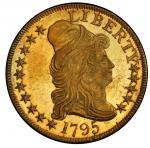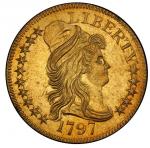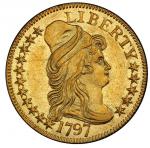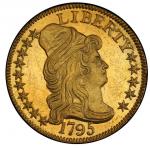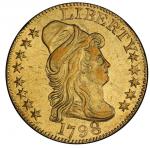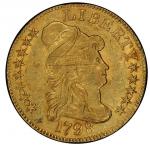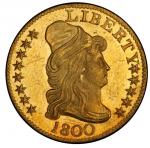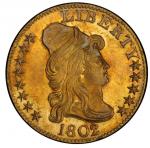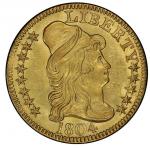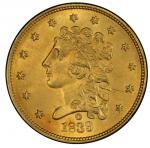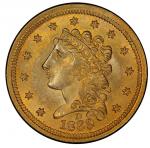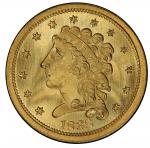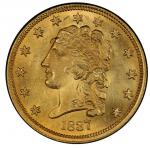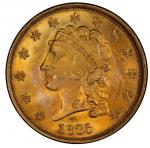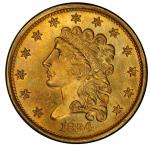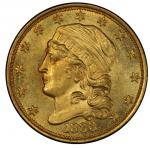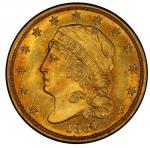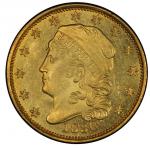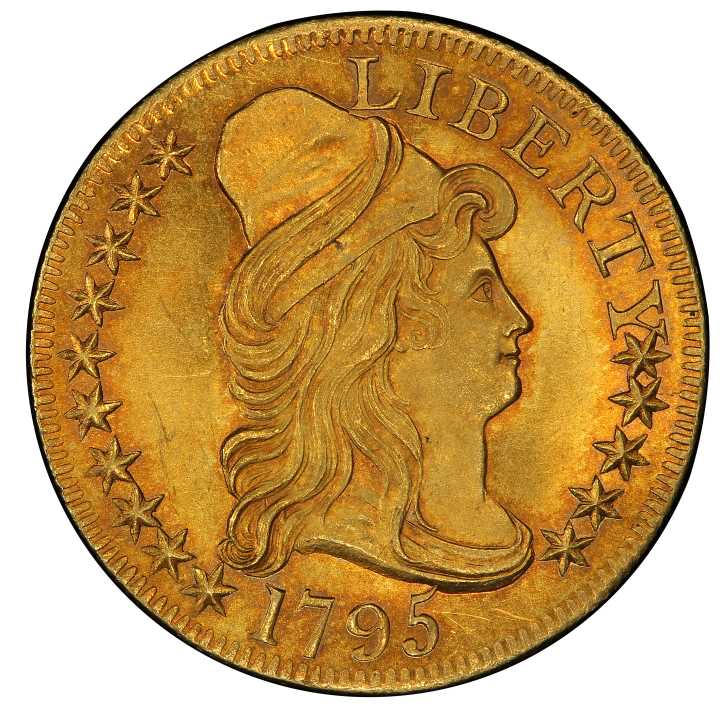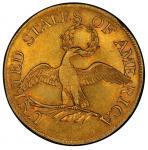T. Harrison Garrett, of Baltimore ... though a comparatively young collector, bids fair to rival Mr. Parmelee in the number and condition of his rarities. -- New York Herald, July 19, 1885.A triumph of survival, cherished by advanced collectors for nearly a century and a half of documented history and likely for decades earlier, this coin pulses with vibrancy and originality unheard of for this issue. The surfaces show an ideal, rich patina, deep yellow gold that turns to coppery orange around design elements, sparkled with hints of ice blue in areas of the periphery. The luster is satiny and intense on both sides, rich in a way rarely encountered on any 18th century U.S. gold coin. There may be no aesthetically superior specimen of this date extant anywhere, indeed, its equal is unlikely to exist. This coins look, beauty, and overall quality are simply unparalleled. Careful examination finds some light marks, including a light abrasion in the lower left obverse field right of stars 3, 4, and 5, along with some truly inconsequential hairlines. A tiny natural inclusion is seen in Libertys cap below the highest lock, and a thin lintmark is vertically oriented between the tops of the letters of OF on the reverse. No significant signs of adjustment are present, just the merest horizontal trace hidden at precise center obverse, leaving each fine detail able to be seen, studied, and enjoyed. A fine die crack or mislaid engraver line on the chest of the eagle, arcing above and then stretching below the centering dot, is rarely seen, but is sharp to its full extent here. Evidence of a die clash is seen on the obverse, among Libertys shoulder drapery between the two principal locks and behind her head parallel to the base of her cap. Light lapping lines are detected at her throat, stronger ones above ED of UNITED on the reverse, a few other individual lines near the periphery elsewhere. A short, fine die crack extends from the rim to star 12 and barely into the field beyond. This state is equivalent to Bass state c, though the line to E appears to be a deep lapping line, not a die crack.This is the single best preserved and most beautiful example of the first American gold issue, a national treasure whose importance echoes beyond the confines of the world of numismatics. United States gold coinage was first called for in Thomas Jeffersons Notes on Coinage, written in the spring of 1784, but the necessity of a stable American currency based upon specie had been evident for decades. George Washington, then a retired general and Virginia planter, told Congressman William Grayson in August 1785 "Mr. Jeffersons ideas upon this subject are plain and simple ... Without a Coinage, ... a Man must travel with a pair of money scales in his pocket, or run the risk of receiving gold at one fourth more by count than weight." While working class citizens of the infant United States may have rarely encountered gold coins, the merchant and planter classes depended upon them. These were the men who enshrined in Article I, Section 10 of the United States Constitution that no state may "make any thing but gold and silver coin a tender in payment of debts."Whereas Jeffersons plan defined just one gold coin, the ten dollar piece called an "eagle," it was the Resolution of Congress of August 8, 1786, which first established "that there shall be two gold coins ... one containing one hundred and twenty-three grains, and one hundred and thirty-four thousands of a grain of fine gold, equal to five dollars, to be stamped in like manner, and to be called a Half-Eagle." By the time the Mint Act of April 2, 1792 was codified, the weight of the half eagle had increased slightly (to 135 grains of "standard" or alloyed gold), and a quarter eagle valued at $2.50 had also been conceived and defined. Still, United States gold coinage remained nothing but a concept. It was the very end of 1792 before the Mint was finally more than words on paper, having evolved into brick and mortar buildings in Philadelphia, full of noisy machinery and hard-working people. Nearly two years after that, regular production of precious metal coinage was begun. Dollars and half dollars of 1794 were the first silver coins struck since the initial "small beginning," 1792 half dismes. And yet, by the end of 1794, fully two years after the Philadelphia Mint was a full-scale operation, gold remained in the future.When that future became the present, this coin is what it looked like. No other extant example of Americas first gold coinage has survived so fine.The praises of this coin have been sung by experienced numismatists for 140 years. J. Colvin Randall, this coins first owner of record, had a legendary eye for quality. When Harold P. Newlin wrote to T. Harrison Garrett to offer his representation services at the auction of the Randall collection in May 1885, he assured Garrett "when Woodwards catalog of the Randall Collection comes out, you will have an opportunity of adding some gems to your cabinet. I have already examined the pieces most carefully and I will be able to give you a fair idea of the value of any you may want." Newlin would attend the sale personally, bidding anonymously for the Baltimore rail magnate. W. Elliot Woodward described 1,749 lots for the Randall sale, to be held over a three day period starting June 29, 1885. While many lots received basic descriptions including little more than the date and denomination of the lot offered, lot 866 received a bit more attention: "1795 No. 4. Mr Randall calls this piece a gem, and values this piece at $25. It is a very beautiful proof."Six days before the sale was to begin, Harold P. Newlin wrote to T. Harrison Garrett from his office at 1807 Pine Street in Philadelphia, recommending bids on more than 70 lots. On lot 866, Newlin advised a bid of $30, with the added comment that this coin was "a beauty" with "beauty" vigorously underscored three times. Though several coins on his list were more expensive, no others garnered such excited commentary. Newlins recommended bid was right on the money: the lot hammered to him, on Garretts behalf, at $30. One of the first die variety experts and a pioneering proponent of focusing on gem quality, J. Colvin Randall collected this coin when it was less than 90 years old. He could have acquired it as early as the late 1850s, when his interest in rare coins blossomed along with a generation of now legendary American numismatists. Sold to Garrett in 1885, it would remain in the same cabinet for nearly a century. This incredible continuity of ownership is rarely encountered, save for coins with the legendary Garrett provenance. This unbroken continuum has ensured the preservation of this coins exceptional surface originality, an asset perhaps even more important than its remarkable grade.In the modern era, this piece continues to be the standard of quality for this famous issue. David Akers, cataloging a choice Mint State 1795 half eagle in 1988, remarked "We know of only one slightly finer 1795 $5 than this one, the Garrett specimen now in the Mack Pogue Collection." Walter Breen chose this coin to illustrate his Complete Encyclopedia. None who attended the first Garrett sale of 1979 have forgotten seeing this piece in the 35 years since passed. This is a crown jewel of not just the D. Brent Pogue collection of early half eagles, but all surviving specimens of this avidly collected and historically vital denomination.

